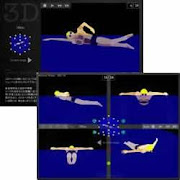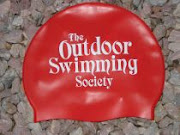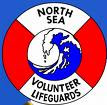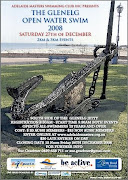 Courtesy of WOWSA, Tsugaru Channel, Japan.
Courtesy of WOWSA, Tsugaru Channel, Japan. The Oceans Seven Challenge includes seven of the toughest channel swims in the world: (1) the cold-water, jellyfish-strewn North Channel (between Ireland and Scotland), (2) the rough and treacherous Cook Strait (between the North and South Islands of New Zealand), (3) the wildly rough and shark-filled Molokai Channel (between Oahu and Molokai Islands in Hawaii), (4) the iconic English Channel, (5) the challenging Catalina Channel, (6) the continental-crossing Strait of Gibraltar and (7) the relatively unknown Tsugaru Channel (between the islands of Honshu and Hokkaido in Japan).
 While these channel swims are well-known to most marathon swimmers, the Tsugaru Channel in northern Japan presents a challenge and an adventure in part of the world that few Westerners know or visit.
While these channel swims are well-known to most marathon swimmers, the Tsugaru Channel in northern Japan presents a challenge and an adventure in part of the world that few Westerners know or visit.We interviewed American Steven Munatones from Huntingtin Beach, California who was one of the early pioneers who swam across this isolated channel in 1990. He discussed about the rough water strait in the northern Pacific Ocean that was first crossed by fellow Californian David Yudovin (shown above).
Daily News of Open Water Swimming: What interested you in swimming across the Tsugaru Channel (Tsugaru Kaikyo in Japanese)?
Steven Munatones: My initial goal was swimming from the Russian island of Kunashiri to Hokkaido in Japan. I received the permission of the Russian government, with particularly strong support from Boris Yeltsin, but the swim encountered insurmountable political problems between the Japanese and Russian governments, so I decided to do the Tsugaru Channel.
Daily News of Open Water Swimming: Where exactly is the Tsugaru Channel?
Steven Munatones: Japan has four main islands. Tokyo, Osaka and Kyoto are on the largest and main island of Honshu. Sapporo, site of the 1972 Winter Olympics, is located on the northernmost island of Hokkaido. Hokkaido is off the coast of eastern Russia. The Tsugaru Channel is the 20 km strait at its narrowest point separating Hokkaido and Honshu. If you fly into Tokyo, you can take a bullet train (shinkansen in Japanese) for about five hours to get up to the north part of Honshu. The largest big city near the channel on the Honshu is Aomori and the largest big city near the channel on the Hokkaido side is Hakodate. On most days, you can clearly see Hokkaido from Honshu and there are ferry boats that can people across the channel, but the water flows between the two islands is tremendous. You can take a risky course starting from the absolute narrowest point, Tappi Misaki, or a less risky course where you can ride on the currents starting from the westernmost coastline of Aomori.
Daily News of Open Water Swimming: What is that part of the world look like?
Steven Munatones: Definitely nothing like Tokyo, Osaka or Kyoto. It is a rugged coastline populated by rugged, friendly people who enjoy the outdoors in an area with an abundance of natural beauty. It is largely undeveloped area with a lot of picturesque fishing villages and small towns that subsist on harvesting seaweed (nori to sushi lovers) and squid. The prefecture on the Honshu side is called Aomori where some of the world’s most delicious apples are grown – huge, juicy apples. The winters are long and harsh up here. On the Hokkaido side, there are a few larger towns, but it is also largely undeveloped with shorelines of rocky, rugged beauty.
Daily News of Open Water Swimming: So it is not totally packed with people like in Tokyo?
Steven Munatones: No, it is exactly the opposite. The small hamlets have relatively sparse populations. Although the locals largely do not speak English, they are quite warm and were extremely helpful to me. They were very hospitable and were happy to have a foreigner come and learn more about their area. I stayed in the area for three weeks waiting for the right day for my swim and lived in a small inn owned by a squid fisherman who was my lead escort boat pilot. We had squid for breakfast, lunch and dinner. I could not imagine how many ways his wife prepared squid. Before dawn, Maki-san would go out and fish in the waters of the Tsugaru Channel – as his father and his grandfather once did. He apparently knew every inch of that waterway. He let me go out and really taught me a lot about the channel, its particularities, its currents and its marine life.
Daily News of Open Water Swimming: How did you plan for the swim?
Steven Munatones: Besides Maki-san, I worked with the engineers who had just finished building the Seikan Tunnel, the world's deepest and longest undersea tunnel under the Tsugaru Channel which had just opened. The Seikan Tunnel, which trains use to pass between the islands of Honshu and Hokkaido, is an engineering marvel like the Chunnel in the English Channel. I also talked and plotted with the divers who helped maintain the Seikan Tunnel. They were actually staying at Maki-san’s inn, too. They would often dive down to 200 meters to monitor the Tunnel and, therefore, knew a lot about the currents and water temperature. Every day, they would go out and tell me what the currents and conditions were like along my planned course. The local Japanese Coast Guard was also very helpful in providing me with loads of information.
Daily News of Open Water Swimming: Was it a tough swim?
Steven Munatones: It was difficult primarily because so much was unknown about the Tsugaru Channel from a swimmer's perspective. However, a few weeks before I did my crossing, David Yudovin crossed the channel in 11 hours 55 minutes, so I was confident it could be crossed. But since David became the first person to swim from Honshu to Hokkaido, I did a double-crossing which turned out to be my longest swim of my life.
Daily News of Open Water Swimming: How did you train for this swim?
Steven Munatones: I trained very hard for this swim. I swam at least 12,000 meters per day in a pool five days per week and did at least one weekend open water practice per week between early March and late July. I also had a good background in long distance training since I had trained under Jim Montrella, a renowned coach of distance swimmers in the US, Ed Spencer and Penny Dean, the English Channel record holder at that time. I started training in Lake Biwa, near Kyoto, in early March even though I only lasted literally a few seconds in the cold water in the first few training sessions. But by April, I had built up to several minutes and my last open water swim before I headed up to the channel was 21 miles. I really had no idea how long my double-crossing would take, so I knew I had to be mentally and physically prepared to swim at least 24 hours, so I put in some serious training sessions.
Daily News of Open Water Swimming: Why did you swim so much in the pool for a channel swim?
Steven Munatones: I knew I needed good speed to work my way across the currents in the channel. The Tsugaru Channel is known for its fast currents that flow between the Sea of Japan and the Pacific Ocean. In fact, many of the large oil tankers that travel from the Middle East to the west coast of America travel through the Tsugaru Channel to apparently take advantage of these currents. When the tankers travel through the channel they get the benefit of a tremendous push out to the Pacific. In order to cross these massive water flows in the time that I wanted, we calculated the necessary speed that I had to maintain. I had to maintain a 1:15 - 1:20 per 100 meters pace for the crossing. So I just did sets of between five and fifteen 1000-meter swims in the pool day after day after day.
Daily News of Open Water Swimming: Wasn't that boring?
Steven Munatones: Yes, unbelievably boring - especially because I did it by myself. A friend gave me keys to his pool and I would go to the pool by myself and swim from 4 - 7 am before work. On the weekends, I very much looked forward to swimming in the lake and the ocean.
Daily News of Open Water Swimming: What kind of workouts did you do in the ocean and lake?
Steven Munatones: Nothing special, I just worked on cold water acclimatization and building up to be able to swim for long distances. I worked my way from, literally, a few seconds in the first training sessions to six swims over 16 miles. In my last preparation swim, I swam for nearly 9 hours. I would swam parallel to the shoreline in relatively shallow waters and set a cooler of drinks and food on a fishing dock. Every 30-45 minutes, I swam over to the dock, grabbed my food or drinks and then continued on. Because these training swims were all done by myself, it was great mental training and helped me prepare emotionally for the swim. It was so easy to just get out. But on my last swim, I was so tired that I couldn’t get home. I ended up checking into a hotel that was near the dock and slept a long, hard sleep. But, after that swim, I was confident that I could go up to 24 hours if necessary.
Daily News of Open Water Swimming: Did you run into any problems?
Steven Munatones: Not really, fortunately. I had a great crew and a main escort boat piloted by Maki-san, although other boats came around to watch or help. I was able to swim from Tappi Misaki on Honshu to southern coast of Hokkaido in 6 hours 11 minutes on the way over. From Hokkaido back to Honshu, I took 6 hours 41 minutes, so I was almost able to negative-split the swim. I started about 7 pm. On the way over, it was cloudy and therefore quite dark throughout the swim, but on the way back, the cloud cover moved and the moonlight shining on the channel created an eerie beauty that channel swimmers can always appreciate. I got a little scared in the very beginning when I took off from Honshu. The ocean swells were large and after about 100 meters, I couldn't see my escort boat. They were momentarily working on their boat lights and I didn't have a paddler or kayaker. In the middle of the night, I couldn't see the boat – I was scared to say the least. But they got the lights back on and my heart rate soon settled down.
Daily News of Open Water Swimming: Any other problems?
Steven Munatones: I had to stop for an oil tanker and was just treading in the water which got me a little cold on the way back. The Japanese Coast Guard was monitoring my progress so I just eggbeatered in the ocean for several minutes. Finally, I just decided to swim in large circles around the escort boats to keep warm. But, Maki-san did a great job and he was rarely out of position. We had great feedings and our planned course was right on plan. There were several cameramen on the media boat and they all got sick in the large swells. Looking through a TV camera and going up and down in the swells had to be tough.
Daily News of Open Water Swimming: Who has also done this swim?
Steven Munatones: David Yudovin did the first crossing a few weeks before me. He had to wait for five weeks for conditions to be right. Since then, several relays have crossed the channel as well as Miyuki Fujita, the Japanese English Channel Queen. One of the most amazing channel swimmers I know, James Pittar of Australia is also going to give it a try as part of his Ocean's Seven Challenge.
With the exponential growth of open water swimming in Japan, I foresee a lot of people also attempting the channel either solo or with relays. I am sure one day someone will try another double-crossing and there may even be the triple-crossing a la Jon Erikson, Philip Rush, and Alison Streeter in the English Channel.
As the world’s waterways continues to attract more and more swimmers looking for unique and interesting challenges of all types, Oceans Seven - including the Tsugaru Channel – will find more people making their way across.
Copyright © 2009 by World Open Water Swimming Association




















No comments:
Post a Comment